1 of 12
Download to read offline
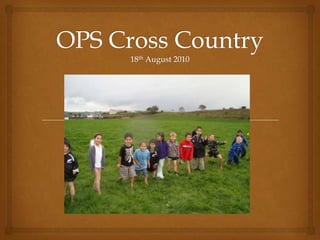
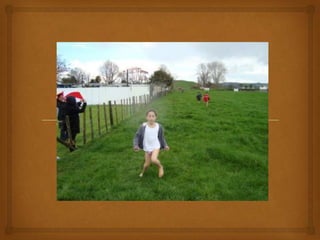
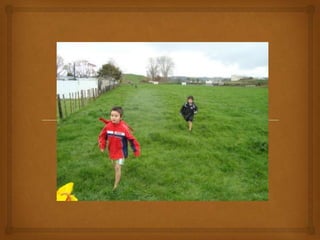
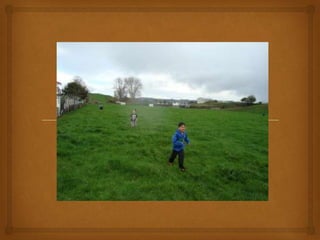

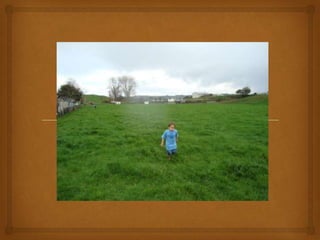






Ad
Recommended
ICT @ OPS
ICT @ OPSCatriona Chrystall
╠²
This document summarizes the integration of ICT at Otorohanga Primary School from February to August 2010. It outlines improvements made to infrastructure including installing new computers and scanners. It also notes the limited use of e-learning in February, with no monitoring or understanding of key digital competencies by most students. By August, e-learning was being integrated across learning areas and student understanding was being captured. The document also establishes national goals for increasing teacher capability, collaboration, leadership in ICT, and community understanding of e-learning. Future focus areas include blogging challenges, linking with other schools, and setting up an online presence.Ops charter 2011
Ops charter 2011Catriona Chrystall
╠²
The document outlines the priorities and goals of Otorohanga Primary School for 2011. Key priorities include improving literacy and numeracy, with specific targets set in reading, writing and numeracy. The school values developing lifelong learners through a focus on teaching and learning programs, e-learning, and developing a quality learning environment. To achieve these goals, the school will focus on areas like literacy learning, numeracy, property maintenance and development, human resources, and financing initiatives to support priorities.Housing And Residence Life Portfolio
Housing And Residence Life Portfoliodexterstroman
╠²
Dexter O. Stroman expresses his interest in the Area Coordinator position, highlighting his diverse educational background and relevant experience in student personnel and supervision. He emphasizes his skills in student development, organizational prowess, and team leadership, along with his commitment to student success and community involvement. Stroman's achievements include enhancing student programs and fostering positive relationships within the university, demonstrating his qualifications for the role.Staff meeting 21 june 2010
Staff meeting 21 june 2010Catriona Chrystall
╠²
The document discusses gathering evidence for assessing students' achievement of mathematics standards in New Zealand. It emphasizes using a range of evidence from classroom observations, student work, assessments, and learning conversations, rather than relying on any single source. Effective assessment also involves moderation, where teachers discuss student work and expectations to improve consistency. Sample mathematics tasks should be meaningful, complex, and part of regular classroom work rather than separate tests.Correction_Project__1330786
Correction_Project__133078641892100
╠²
This summary provides an overview of Jean Paul Gaultier's iconic designs from the 1940s to the 2010s and their influence on fashion:
- Jean Paul Gaultier launched his first collection in 1974 and introduced the iconic "New Look" silhouette in the 1980s, separating early fashion from the stuffy formality of the forties.
- Gaultier and Coco Chanel were two of the most influential fashion designers of the early 20th century. While different in their aesthetics, both worked to liberate women's fashion from constraints and embrace new concepts of femininity.
- Iconic pieces from Gaultier like the bar jacket and boxy suit in the 1940s-50s360 Reach Branding Survey Results
360 Reach Branding Survey Resultsdexterstroman
╠²
The document summarizes the branding survey results of an individual named Dexter, highlighting his perceived brand attributes, skills, strengths, and weaknesses. Key attributes identified include being community-oriented, dependable, and persuasive, with significant strengths in coaching and inspiring others. Feedback indicates areas for improvement such as decision-making firmness and organizational skills, while also noting Dexter's potential to excel further in his professional environment.2010 change
2010 changeCatriona Chrystall
╠²
This document discusses conceptual planning for teaching students. It defines key terms like concepts, contexts, and content. Concepts are broad ideas like communication, change, and sustainability. Contexts provide clarification on concepts, like how roles and responsibilities provide context for citizenship. Content includes specific material and ideas that bring concepts to life, such as local and global examples of conservation for the concept of conservation. The document encourages using these elements of concepts, contexts, and content to develop curriculum that will prepare students for the future.Otorohanga hui
Otorohanga huiCatriona Chrystall
╠²
This document summarizes a student achievement hui that took place on August 15, 2012. It included welcome remarks from Ernest of the Board of Trustees, presentations on national reading standards from Mike Tribe of the Ministry of Education and Christine Jeffs of Te Toi Tupu, and a discussion of partnerships to improve student achievement. The group then participated in a draw meat pack and farewell with Ernest.Ops ŌĆō our ict journey 2010 2012
Ops ŌĆō our ict journey 2010 2012Catriona Chrystall
╠²
This document summarizes the ICT journey of a decile 2 school in Otorohanga, New Zealand from 2010-2012. It had three goals: for teachers to effectively integrate e-learning into their practice and create an innovative learning environment for students. To achieve this, the school set up class wikis and blogs, trialed online programs, and adopted the Daily 5 literacy framework. This was done to improve student outcomes, empower independent learning, and help students apply strategies across subjects. As a result, many students made over 1.5 years of reading progress in 3 terms and teachers saw the benefits of changing their practice to be more student-centered.4 april staff meeting
4 april staff meetingCatriona Chrystall
╠²
Teachers are encouraged to engage in inquiry to improve outcomes for M─üori and Pasifika students. Inquiry involves reflection on one's own teaching and on students' needs in order to determine the most effective evidence-based strategies. The inquiry process includes focusing on important student learning needs, investigating influencing factors, designing an action plan to adapt literacy teaching, and evaluating the results to inform future teaching.4 april staff meeting
4 april staff meetingCatriona Chrystall
╠²
Teaching as Inquiry at OPS focuses on teachers reflecting on their own practices and students' needs to improve outcomes for Maori and Pasifika students. The inquiry process involves teachers analyzing class data, investigating factors influencing student learning, designing evidence-based strategies tailored to their students, and evaluating the effectiveness of their teaching. Teachers then use what they've learned to adapt their practices and determine the implications for future teaching through ongoing reflection and collaboration with colleagues.Staff meeting focus and release timetable t3
Staff meeting focus and release timetable t3Catriona Chrystall
╠²
The document outlines the staff meeting focus and release timetable for Term 3. It schedules literacy, numeracy, and ICT as the weekly focuses. It also schedules various teachers, including Kristen, Catriona, and Heremaia, for release days on Mondays, Tuesdays, Thursdays and Fridays throughout the term, with the release times set from 9am to 3pm each day.Gaylene's timetable term 3
Gaylene's timetable term 3Catriona Chrystall
╠²
Gaylene's teaching timetable for Term 3 weeks 1-4 shows that she will teach numeracy and literacy groups for different classes on Mondays through Thursdays, with Fridays spent releasing other teachers. During weeks 5-10, she will teach full time in Room 1.Tuanspresentation
TuanspresentationCatriona Chrystall
╠²
The document provides ideas for integrating information and communication technology (ICT) into mathematics programs, including using math task boards, digital learning objects, CD-ROMs, the internet, data projectors, laptops, and software programs like Inspiration and Excel. Some specific resources mentioned include the learning objects website, interactive whiteboards, and websites with math games and worksheets.How to Manage Inventory Movement in Odoo 18 POS
How to Manage Inventory Movement in Odoo 18 POSCeline George
╠²
Inventory management in the Odoo 18 Point of Sale system is tightly integrated with the inventory module, offering a solution to businesses to manage sales and stock in one united system.Health Care Planning and Organization of Health Care at Various Levels ŌĆō Unit...
Health Care Planning and Organization of Health Care at Various Levels ŌĆō Unit...RAKESH SAJJAN
╠²
This comprehensive PowerPoint presentation is prepared for B.Sc Nursing 5th Semester students and covers Unit 2 of Community Health Nursing ŌĆō I based on the Indian Nursing Council (INC) syllabus. The unit focuses on the planning, structure, and functioning of health care services at various levels in India. It is especially useful for nursing educators and students preparing for university exams, internal assessments, or professional teaching assignments.
The content of this presentation includes:
Historical development of health planning in India
Detailed study of various health committees: Bhore, Mudaliar, Kartar Singh, Shrivastava Committee, etc.
Overview of major health commissions
In-depth understanding of Five-Year Plans and their impact on health care
Community participation and stakeholder involvement in health care planning
Structure of health care delivery system at central, state, district, and peripheral levels
Concepts and implementation of Primary Health Care (PHC) and Sustainable Development Goals (SDGs)
Introduction to Comprehensive Primary Health Care (CPHC) and Health and Wellness Centers (HWCs)
Expanded role of Mid-Level Health Providers (MLHPs) and Community Health Providers (CHPs)
Explanation of national health policies: NHP 1983, 2002, and 2017
Key national missions and schemes including:
National Health Mission (NHM)
National Rural Health Mission (NRHM)
National Urban Health Mission (NUHM)
Ayushman Bharat ŌĆō Pradhan Mantri Jan Arogya Yojana (PM-JAY)
Universal Health Coverage (UHC) and IndiaŌĆÖs commitment to equitable health care
This presentation is ideal for:
Nursing students (B.Sc, GNM, Post Basic)
Nursing tutors and faculty
Health educators
Competitive exam aspirants in nursing and public health
It is organized in a clear, point-wise format with relevant terminologies and a focus on applied knowledge. The slides can also be used for community health demonstrations, teaching sessions, and revision guides.SCHIZOPHRENIA OTHER PSYCHOTIC DISORDER LIKE Persistent delusion/Capgras syndr...
SCHIZOPHRENIA OTHER PSYCHOTIC DISORDER LIKE Persistent delusion/Capgras syndr...parmarjuli1412
╠²
SCHIZOPHRENIA INCLUDED TOPIC IS INTRODUCTION, DEFINITION OF GENERAL TERM IN PSYCHIATRIC, THEN DIFINITION OF SCHIZOPHRENIA, EPIDERMIOLOGY, ETIOLOGICAL FACTORS, CLINICAL FEATURE(SIGN AND SYMPTOMS OF SCHIZOPHRENIA), CLINICAL TYPES OF SCHIZOPHRENIA, DIAGNOSIS, INVESTIGATION, TREATMENT MODALITIES(PHARMACOLOGICAL MANAGEMENT, PSYCHOTHERAPY, ECT, PSYCHO-SOCIO-REHABILITATION), NURSING MANAGEMENT(ASSESSMENT,DIAGNOSIS,NURSING INTERVENTION,AND EVALUATION), OTHER PSYCHOTIC DISORDER LIKE Persistent delusion/Capgras syndrome(The Delusion of Doubles)/Acute and Transient Psychotic Disorders/Induced Delusional Disorders/Schizoaffective Disorder /CAPGRAS SYNDROME(DELUSION OF DOUBLE), GERIATRIC CONSIDERATION, FOLLOW UP, HOMECARE AND REHABILITATION OF THE PATIENT, University of Ghana Cracks Down on Misconduct: Over 100 Students Sanctioned
University of Ghana Cracks Down on Misconduct: Over 100 Students SanctionedKweku Zurek
╠²
University of Ghana Cracks Down on Misconduct: Over 100 Students Sanctioned
Chalukyas of Gujrat, Solanki Dynasty NEP.pptx
Chalukyas of Gujrat, Solanki Dynasty NEP.pptxDr. Ravi Shankar Arya Mahila P. G. College, Banaras Hindu University, Varanasi, India.
╠²
This presentation has been made keeping in mind the students of undergraduate and postgraduate level. In this slide try to present the brief history of Chaulukyas of Gujrat up to Kumarpala To keep the facts in a natural form and to display the material in more detail, the help of various books, websites and online medium has been taken. Whatever medium the material or facts have been taken from, an attempt has been made by the presenter to give their reference at the end.
Chaulukya or Solanki was one of the Rajputs born from Agnikul. In the Vadnagar inscription, the origin of this dynasty is told from Brahma's Chauluk or Kamandalu. They ruled in Gujarat from the latter half of the tenth century to the beginning of the thirteenth century. Their capital was in Anahilwad. It is not certain whether it had any relation with the Chalukya dynasty of the south or not. It is worth mentioning that the name of the dynasty of the south was 'Chaluky' while the dynasty of Gujarat has been called 'Chaulukya'. The rulers of this dynasty were the supporters and patrons of Jainism.Assisting Individuals and Families to Promote and Maintain Health ŌĆō Unit 7 | ...
Assisting Individuals and Families to Promote and Maintain Health ŌĆō Unit 7 | ...RAKESH SAJJAN
╠²
This PowerPoint presentation is based on Unit 7 ŌĆō Assisting Individuals and Families to Promote and Maintain Their Health, a core topic in Community Health Nursing ŌĆō I for 5th Semester B.Sc Nursing students, as per the Indian Nursing Council (INC) guidelines.
The unit emphasizes the nurseŌĆÖs role in family-centered care, early detection of health problems, health promotion, and appropriate referrals, especially in the context of home visits and community outreach. It also strengthens the studentŌĆÖs understanding of nursing responsibilities in real-life community settings.
¤ōś Key Topics Covered in the Presentation:
Introduction to family health care: needs, principles, and objectives
Assessment of health needs of individuals, families, and groups
Observation and documentation during home visits and field assessments
Identifying risk factors: environmental, behavioral, genetic, and social
Conducting growth and development monitoring in infants and children
Recording and observing:
Milestones of development
Menstrual health and reproductive cycle
Temperature, blood pressure, and vital signs
General physical appearance and personal hygiene
Social assessment: understanding family dynamics, occupation, income, living conditions
Health education and counseling for individuals and families
Guidelines for early detection and referral of communicable and non-communicable diseases
Maintenance of family health records and individual health cards
Assisting families with:
Maternal and child care
Elderly and chronic disease management
Hygiene and nutrition guidance
Utilization of community resources ŌĆō referral linkages, support services, and local health programs
Role of nurse in coordinating care, advocating for vulnerable individuals, and empowering families
Promoting self-care and family participation in disease prevention and health maintenance
This presentation is highly useful for:
Nursing students preparing for internal exams, university theory papers, or community postings
Health educators conducting family teaching sessions
Students conducting fieldwork and project work during community postings
Public health nurses and outreach workers dealing with preventive, promotive, and rehabilitative care
ItŌĆÖs structured in a step-by-step format, featuring tables, case examples, and simplified explanations tailored for easy understanding and classroom delivery.Pests of Maize: An comprehensive overview.pptx
Pests of Maize: An comprehensive overview.pptxArshad Shaikh
╠²
Maize is susceptible to various pests that can significantly impact yields. Key pests include the fall armyworm, stem borers, cob earworms, shoot fly. These pests can cause extensive damage, from leaf feeding and stalk tunneling to grain destruction. Effective management strategies, such as integrated pest management (IPM), resistant varieties, biological control, and judicious use of chemicals, are essential to mitigate losses and ensure sustainable maize production.ECONOMICS, DISASTER MANAGEMENT, ROAD SAFETY - STUDY MATERIAL [10TH]
ECONOMICS, DISASTER MANAGEMENT, ROAD SAFETY - STUDY MATERIAL [10TH]SHERAZ AHMAD LONE
╠²
This study material for Class 10th covers the core subjects of Economics, Disaster Management, and Road Safety Education, developed strictly in line with the JKBOSE textbook. It presents the content in a simplified, structured, and student-friendly format, ensuring clarity in concepts. The material includes reframed explanations, flowcharts, infographics, and key point summaries to support better understanding and retention. Designed for classroom teaching and exam preparation, it aims to enhance comprehension, critical thinking, and practical awareness among students.More Related Content
More from Catriona Chrystall (8)
Otorohanga hui
Otorohanga huiCatriona Chrystall
╠²
This document summarizes a student achievement hui that took place on August 15, 2012. It included welcome remarks from Ernest of the Board of Trustees, presentations on national reading standards from Mike Tribe of the Ministry of Education and Christine Jeffs of Te Toi Tupu, and a discussion of partnerships to improve student achievement. The group then participated in a draw meat pack and farewell with Ernest.Ops ŌĆō our ict journey 2010 2012
Ops ŌĆō our ict journey 2010 2012Catriona Chrystall
╠²
This document summarizes the ICT journey of a decile 2 school in Otorohanga, New Zealand from 2010-2012. It had three goals: for teachers to effectively integrate e-learning into their practice and create an innovative learning environment for students. To achieve this, the school set up class wikis and blogs, trialed online programs, and adopted the Daily 5 literacy framework. This was done to improve student outcomes, empower independent learning, and help students apply strategies across subjects. As a result, many students made over 1.5 years of reading progress in 3 terms and teachers saw the benefits of changing their practice to be more student-centered.4 april staff meeting
4 april staff meetingCatriona Chrystall
╠²
Teachers are encouraged to engage in inquiry to improve outcomes for M─üori and Pasifika students. Inquiry involves reflection on one's own teaching and on students' needs in order to determine the most effective evidence-based strategies. The inquiry process includes focusing on important student learning needs, investigating influencing factors, designing an action plan to adapt literacy teaching, and evaluating the results to inform future teaching.4 april staff meeting
4 april staff meetingCatriona Chrystall
╠²
Teaching as Inquiry at OPS focuses on teachers reflecting on their own practices and students' needs to improve outcomes for Maori and Pasifika students. The inquiry process involves teachers analyzing class data, investigating factors influencing student learning, designing evidence-based strategies tailored to their students, and evaluating the effectiveness of their teaching. Teachers then use what they've learned to adapt their practices and determine the implications for future teaching through ongoing reflection and collaboration with colleagues.Staff meeting focus and release timetable t3
Staff meeting focus and release timetable t3Catriona Chrystall
╠²
The document outlines the staff meeting focus and release timetable for Term 3. It schedules literacy, numeracy, and ICT as the weekly focuses. It also schedules various teachers, including Kristen, Catriona, and Heremaia, for release days on Mondays, Tuesdays, Thursdays and Fridays throughout the term, with the release times set from 9am to 3pm each day.Gaylene's timetable term 3
Gaylene's timetable term 3Catriona Chrystall
╠²
Gaylene's teaching timetable for Term 3 weeks 1-4 shows that she will teach numeracy and literacy groups for different classes on Mondays through Thursdays, with Fridays spent releasing other teachers. During weeks 5-10, she will teach full time in Room 1.Tuanspresentation
TuanspresentationCatriona Chrystall
╠²
The document provides ideas for integrating information and communication technology (ICT) into mathematics programs, including using math task boards, digital learning objects, CD-ROMs, the internet, data projectors, laptops, and software programs like Inspiration and Excel. Some specific resources mentioned include the learning objects website, interactive whiteboards, and websites with math games and worksheets.Recently uploaded (20)
How to Manage Inventory Movement in Odoo 18 POS
How to Manage Inventory Movement in Odoo 18 POSCeline George
╠²
Inventory management in the Odoo 18 Point of Sale system is tightly integrated with the inventory module, offering a solution to businesses to manage sales and stock in one united system.Health Care Planning and Organization of Health Care at Various Levels ŌĆō Unit...
Health Care Planning and Organization of Health Care at Various Levels ŌĆō Unit...RAKESH SAJJAN
╠²
This comprehensive PowerPoint presentation is prepared for B.Sc Nursing 5th Semester students and covers Unit 2 of Community Health Nursing ŌĆō I based on the Indian Nursing Council (INC) syllabus. The unit focuses on the planning, structure, and functioning of health care services at various levels in India. It is especially useful for nursing educators and students preparing for university exams, internal assessments, or professional teaching assignments.
The content of this presentation includes:
Historical development of health planning in India
Detailed study of various health committees: Bhore, Mudaliar, Kartar Singh, Shrivastava Committee, etc.
Overview of major health commissions
In-depth understanding of Five-Year Plans and their impact on health care
Community participation and stakeholder involvement in health care planning
Structure of health care delivery system at central, state, district, and peripheral levels
Concepts and implementation of Primary Health Care (PHC) and Sustainable Development Goals (SDGs)
Introduction to Comprehensive Primary Health Care (CPHC) and Health and Wellness Centers (HWCs)
Expanded role of Mid-Level Health Providers (MLHPs) and Community Health Providers (CHPs)
Explanation of national health policies: NHP 1983, 2002, and 2017
Key national missions and schemes including:
National Health Mission (NHM)
National Rural Health Mission (NRHM)
National Urban Health Mission (NUHM)
Ayushman Bharat ŌĆō Pradhan Mantri Jan Arogya Yojana (PM-JAY)
Universal Health Coverage (UHC) and IndiaŌĆÖs commitment to equitable health care
This presentation is ideal for:
Nursing students (B.Sc, GNM, Post Basic)
Nursing tutors and faculty
Health educators
Competitive exam aspirants in nursing and public health
It is organized in a clear, point-wise format with relevant terminologies and a focus on applied knowledge. The slides can also be used for community health demonstrations, teaching sessions, and revision guides.SCHIZOPHRENIA OTHER PSYCHOTIC DISORDER LIKE Persistent delusion/Capgras syndr...
SCHIZOPHRENIA OTHER PSYCHOTIC DISORDER LIKE Persistent delusion/Capgras syndr...parmarjuli1412
╠²
SCHIZOPHRENIA INCLUDED TOPIC IS INTRODUCTION, DEFINITION OF GENERAL TERM IN PSYCHIATRIC, THEN DIFINITION OF SCHIZOPHRENIA, EPIDERMIOLOGY, ETIOLOGICAL FACTORS, CLINICAL FEATURE(SIGN AND SYMPTOMS OF SCHIZOPHRENIA), CLINICAL TYPES OF SCHIZOPHRENIA, DIAGNOSIS, INVESTIGATION, TREATMENT MODALITIES(PHARMACOLOGICAL MANAGEMENT, PSYCHOTHERAPY, ECT, PSYCHO-SOCIO-REHABILITATION), NURSING MANAGEMENT(ASSESSMENT,DIAGNOSIS,NURSING INTERVENTION,AND EVALUATION), OTHER PSYCHOTIC DISORDER LIKE Persistent delusion/Capgras syndrome(The Delusion of Doubles)/Acute and Transient Psychotic Disorders/Induced Delusional Disorders/Schizoaffective Disorder /CAPGRAS SYNDROME(DELUSION OF DOUBLE), GERIATRIC CONSIDERATION, FOLLOW UP, HOMECARE AND REHABILITATION OF THE PATIENT, University of Ghana Cracks Down on Misconduct: Over 100 Students Sanctioned
University of Ghana Cracks Down on Misconduct: Over 100 Students SanctionedKweku Zurek
╠²
University of Ghana Cracks Down on Misconduct: Over 100 Students Sanctioned
Chalukyas of Gujrat, Solanki Dynasty NEP.pptx
Chalukyas of Gujrat, Solanki Dynasty NEP.pptxDr. Ravi Shankar Arya Mahila P. G. College, Banaras Hindu University, Varanasi, India.
╠²
This presentation has been made keeping in mind the students of undergraduate and postgraduate level. In this slide try to present the brief history of Chaulukyas of Gujrat up to Kumarpala To keep the facts in a natural form and to display the material in more detail, the help of various books, websites and online medium has been taken. Whatever medium the material or facts have been taken from, an attempt has been made by the presenter to give their reference at the end.
Chaulukya or Solanki was one of the Rajputs born from Agnikul. In the Vadnagar inscription, the origin of this dynasty is told from Brahma's Chauluk or Kamandalu. They ruled in Gujarat from the latter half of the tenth century to the beginning of the thirteenth century. Their capital was in Anahilwad. It is not certain whether it had any relation with the Chalukya dynasty of the south or not. It is worth mentioning that the name of the dynasty of the south was 'Chaluky' while the dynasty of Gujarat has been called 'Chaulukya'. The rulers of this dynasty were the supporters and patrons of Jainism.Assisting Individuals and Families to Promote and Maintain Health ŌĆō Unit 7 | ...
Assisting Individuals and Families to Promote and Maintain Health ŌĆō Unit 7 | ...RAKESH SAJJAN
╠²
This PowerPoint presentation is based on Unit 7 ŌĆō Assisting Individuals and Families to Promote and Maintain Their Health, a core topic in Community Health Nursing ŌĆō I for 5th Semester B.Sc Nursing students, as per the Indian Nursing Council (INC) guidelines.
The unit emphasizes the nurseŌĆÖs role in family-centered care, early detection of health problems, health promotion, and appropriate referrals, especially in the context of home visits and community outreach. It also strengthens the studentŌĆÖs understanding of nursing responsibilities in real-life community settings.
¤ōś Key Topics Covered in the Presentation:
Introduction to family health care: needs, principles, and objectives
Assessment of health needs of individuals, families, and groups
Observation and documentation during home visits and field assessments
Identifying risk factors: environmental, behavioral, genetic, and social
Conducting growth and development monitoring in infants and children
Recording and observing:
Milestones of development
Menstrual health and reproductive cycle
Temperature, blood pressure, and vital signs
General physical appearance and personal hygiene
Social assessment: understanding family dynamics, occupation, income, living conditions
Health education and counseling for individuals and families
Guidelines for early detection and referral of communicable and non-communicable diseases
Maintenance of family health records and individual health cards
Assisting families with:
Maternal and child care
Elderly and chronic disease management
Hygiene and nutrition guidance
Utilization of community resources ŌĆō referral linkages, support services, and local health programs
Role of nurse in coordinating care, advocating for vulnerable individuals, and empowering families
Promoting self-care and family participation in disease prevention and health maintenance
This presentation is highly useful for:
Nursing students preparing for internal exams, university theory papers, or community postings
Health educators conducting family teaching sessions
Students conducting fieldwork and project work during community postings
Public health nurses and outreach workers dealing with preventive, promotive, and rehabilitative care
ItŌĆÖs structured in a step-by-step format, featuring tables, case examples, and simplified explanations tailored for easy understanding and classroom delivery.Pests of Maize: An comprehensive overview.pptx
Pests of Maize: An comprehensive overview.pptxArshad Shaikh
╠²
Maize is susceptible to various pests that can significantly impact yields. Key pests include the fall armyworm, stem borers, cob earworms, shoot fly. These pests can cause extensive damage, from leaf feeding and stalk tunneling to grain destruction. Effective management strategies, such as integrated pest management (IPM), resistant varieties, biological control, and judicious use of chemicals, are essential to mitigate losses and ensure sustainable maize production.ECONOMICS, DISASTER MANAGEMENT, ROAD SAFETY - STUDY MATERIAL [10TH]
ECONOMICS, DISASTER MANAGEMENT, ROAD SAFETY - STUDY MATERIAL [10TH]SHERAZ AHMAD LONE
╠²
This study material for Class 10th covers the core subjects of Economics, Disaster Management, and Road Safety Education, developed strictly in line with the JKBOSE textbook. It presents the content in a simplified, structured, and student-friendly format, ensuring clarity in concepts. The material includes reframed explanations, flowcharts, infographics, and key point summaries to support better understanding and retention. Designed for classroom teaching and exam preparation, it aims to enhance comprehension, critical thinking, and practical awareness among students.LDMMIA Practitioner Level Orientation Updates
LDMMIA Practitioner Level Orientation UpdatesLDM & Mia eStudios
╠²
See our 2 Starter PDFs within a Compressed, Zip Drive. Within Shop. Videos will be available Before the Weekend of 6/14th. For the US, Happy Fathers Day Weekend. (Our readers/teams are global.) Also, our content remains timeless for Future Grad Students seeking updates.
After about a Year or 10, I retire older content. Literally up to under 10 yrs. We will be 19 yrs old this Aug for Love and Divinity in Motion (LDM). How old are we? So funny. Our oldest profile is X, formerly Twitter. From our old Apple Podcast Years.
https://ldm-mia.creator-spring.com
Session/Lesson 1 -Intro
REIKI- YOGA ŌĆ£ORIENTATIONŌĆØ
It helps to understand the text behind anything. This improves our performance and confidence.
Your training will be mixed media. Includes Rehab Intro and Meditation vods, all sold separately.
Editing our Vods & New Shop. Retail under $30 per item.
*Store Fees will apply. *Digital Should be low cost.
Thank you for attending our free workshops. Those can be used with any Reiki Yoga training package. Traditional Reiki does host rules and ethics. Its silent and within the JP Culture/Area/Training/Word of Mouth. It allows remote healing but thereŌĆÖs limits for practitioners and masters. We are not allowed to share certain secrets/tools. Some content is designed only for ŌĆ£MastersŌĆØ...
Next Upload will be our Video package for Session 1. Prices will be affordable as possible. Thx for becoming a "Practitioner Level" Student.
Updates so far, are every week for spring. Summer should be a similar schedule. Thx for visitings, attending, and following LDMMIA.
Social Media:
https://x.com/OnlineDrLeZ
and
https://www.instagram.com/chelleofsl/
Birnagar High School Platinum Jubilee Quiz.pptx
Birnagar High School Platinum Jubilee Quiz.pptxSourav Kr Podder
╠²
Birnagar High School Platinum Jubilee Celebration QuizRay Dalio How Countries go Broke the Big Cycle
Ray Dalio How Countries go Broke the Big CycleDadang Solihin
╠²
A complete and practical understanding of the Big Debt Cycle. A much more practical understanding of how supply and demand really work compared to the conventional economic thinking. A complete and practical understanding of the Overall Big Cycle, which is driven by the Big Debt Cycle and the other major cycles, including the big political cycle within countries that changes political orders and the big geopolitical cycle that changes world orders.Communicable Diseases and National Health Programs ŌĆō Unit 9 | B.Sc Nursing 5t...
Communicable Diseases and National Health Programs ŌĆō Unit 9 | B.Sc Nursing 5t...RAKESH SAJJAN
╠²
This PowerPoint presentation covers Unit 9 ŌĆō Communicable Diseases and National Health Programs, a core part of the 5th Semester B.Sc Nursing (Community Health Nursing ŌĆō I) syllabus, as outlined by the Indian Nursing Council (INC).
This unit enables nursing students to understand the epidemiology, prevention, control, and nursing management of common communicable diseases in India, while also offering a structured overview of the National Health Programs implemented to address them.
The content is critical for effective field practice, disease surveillance, early detection, referral, and health education, equipping students to participate in public health interventions and outbreak control at community and national levels.
¤ōś Key Topics Covered in the PPT:
Definition and classification of communicable diseases
Modes of transmission and chain of infection
Common communicable diseases in India:
Malaria
Tuberculosis
Leprosy
Dengue
HIV/AIDS
Hepatitis
COVID-19 (if included in the current curriculum)
Diarrheal diseases
Acute Respiratory Infections (ARIs)
Epidemiological factors, causative agents, symptoms, and incubation periods
Prevention and control strategies: primary, secondary, and tertiary levels
Nursing responsibilities in patient care, contact tracing, community surveillance, and outbreak control
Health education and behavior change communication for community awareness
Vaccination schedules and cold chain maintenance
National Health Programs related to communicable diseases:
National Vector Borne Disease Control Program (NVBDCP)
Revised National Tuberculosis Control Program (RNTCP)
National Leprosy Eradication Program (NLEP)
National AIDS Control Program (NACP)
Universal Immunization Program (UIP)
IDSP ŌĆō Integrated Disease Surveillance Program
Overview of standard treatment protocols, referral mechanisms, and community nurseŌĆÖs role in program implementation
This presentation is ideal for:
Nursing students preparing for university exams, class tests, and field projects
Tutors teaching infectious disease nursing and public health interventions
Nurses involved in immunization, outbreak investigation, and contact tracing
It provides a student-friendly breakdown of concepts, aligned with national priorities, including flowcharts, tables, case examples, and simplified text for field-level application.How to Manage Multi Language for Invoice in Odoo 18
How to Manage Multi Language for Invoice in Odoo 18Celine George
╠²
Odoo supports multi-language functionality for invoices, allowing you to generate invoices in your customersŌĆÖ preferred languages. Multi-language support for invoices is crucial for businesses operating in global markets or dealing with customers from different linguistic backgrounds. Chalukyas of Gujrat, Solanki Dynasty NEP.pptx
Chalukyas of Gujrat, Solanki Dynasty NEP.pptxDr. Ravi Shankar Arya Mahila P. G. College, Banaras Hindu University, Varanasi, India.
╠²
Ad
Ops cross country
- 1. OPS Cross Country18th August 2010
